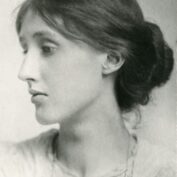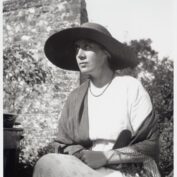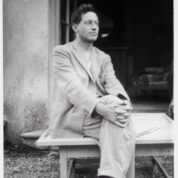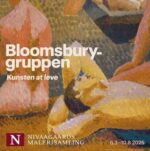The Bloomsbury Group
The Art of Life
6 March - 10 August 2025
The Nivaagaard Collection is proud to present an exhibition on the Bloomsbury Group – the first ever in Denmark. Celebrating what they called the art of life, the Bloomsbury circle of British pioneers within the fields of literature, art, design, and economics created a groundbreaking movement in the decades surrounding World War I, and their ideas still resonate with us today, 100 years later. The special exhibition at The Nivaagaard Collection presents the cultural and artistic legacy of the Bloomsbury Group, exploring how tolerance, openness and a yearning for freedom were central to their experimental quest to live better. The exhibition opens on 6 March and runs until 10 August 2025.
The Bloomsbury Group emerged around the English writer Virginia Woolf and her sister, the painter Vanessa Bell. It is named after the London neighbourhood where the group was based for many years. A shared urge to influence the world through painting, thinking, writing, and dreaming bound this group of painters, writers, philosophers, economists and critical thinkers together for sixty years and through two world wars. Together and individually, they left a significant mark on the twentieth century.
Fuelled by free thinking, acceptance of the individual, and a fundamentally creative approach to life, the Bloomsbury Group actively lived a utopian vision that marked a definite break with the Victorian era. Rejecting the dominant norms of their time, they rallied around a philosophy that celebrated truth, authenticity, personal relationships, and beauty above all else.
The exhibition presents more than 120 artworks and objects borrowed from the finest collections in the UK, focusing on the Bloomsbury Group’s most active years, 1910–1930, and staged with the group’s textiles and photographs as a backdrop.

Virginia Stephen (Woolf), 1903

Vanessa Bell, 1913

Duncan Grant, 1933
The urge to experiment
For many years, the Bloomsbury Group was better known for its reputation than for its art and work. The rejection of conventions and the urge and willingness to experiment manifested in their approach to sexuality, gender and relationships, but also in their various professional fields. For example, there was the world-famous economist who also designed ballet skirts. The writers who addressed psychology, gender and sexuality in entirely new ways. The artists who painted on walls and ceilings and designed furniture so radical that their contemporaries called it ‘immoral’. And the various historians, theorists and psychoanalysts who were also part of this incomparable circle of friends.
Virginia Woolf is renowned for her experimental novels, which delved deep into the recesses of the human mind and followed its streams of consciousness. John Maynard Keynes, with his groundbreaking economic theories, had a tremendous impact on twentieth-century international economics and helped lay down the foundations for the welfare state. Roger Fry, Duncan Grant and Vanessa Bell introduced Post-Impressionism in English art, merging art with design and craftsmanship. Under the auspices of their shared Omega Workshops, they inspired generations of artists with their use of colour and patterns. E. M. Forster’s novels about a Britain undergoing societal upheaval at the dawn of the twentieth century remain relevant for their vivid and poignant depictions of class, identity and relationships across social boundaries.
Big questions answered through lived life
The members of the Bloomsbury Group made some of their most significant contributions against the backdrop of World War I and its aftermath, cutting to the core of existential questions:
How should we structure society? How much should we work? How do we take control of the coming technological revolution? How can we create relationships that accommodate diversity and individual freedom while also fostering care and shared responsibility?
These questions were not only theoretical but also practical for the Bloomsbury Group. Back in the early 1900s, they took a firm grasp of issues we still see reflected today in discussions on gender, identity, creativity, war, imperialism and alternative lifestyles.
Museum director Andrea Rygg Karberg explains:
"The Bloomsbury Group anticipated later artistic collectives and new family constellations, conceived the welfare state, created designs for an integrated lifestyle, and are in every way deeply relevant today. In recent years, we’ve seen a Bloomsbury revival: in 2023, Dior Men created a collection inspired by artist Duncan Grant, who lived and worked with Vanessa Bell. Young authors worldwide frequently reference Virginia Woolf, whose novel Orlando (1928) has been claimed as the first English novel about trans identity. And the imperfect, lush richness of the Bloomsbury painters’ decorative embellishments of all sorts of things within their homes resonates with the organic, ecological aesthetic found in present-day art forms.
We are thrilled to present the Bloomsbury Group to a Danish audience in a vibrant, vivid exhibition accompanied by an extensive interdisciplinary programme of events."
The exhibition showcases the Bloomsbury Group’s work within the fields of visual art, design, literature, politics and economics, presenting an array of paintings, drawings, ceramics, books, furniture, design objects, letters and video.
Exhibition architects:
Alexander H. Damsbo og Henrik Ingemann Nielsen, TREBEN.DK
The exhibition is supported by:
Aage og Johanne Louis-Hansens Fond, Hoffmann og Husmans Fond, Augustinus Fonden, Knud Højgaards Fond, Sportgoodsfonden, William Demant Fonden, A.P. Mortensen og Hustrus Legat, Jørgen Krygers og Anne Ammitzbølls Fond, Dronning Margrethes og Prins Henriks Fond, and Gangstedfonden.

